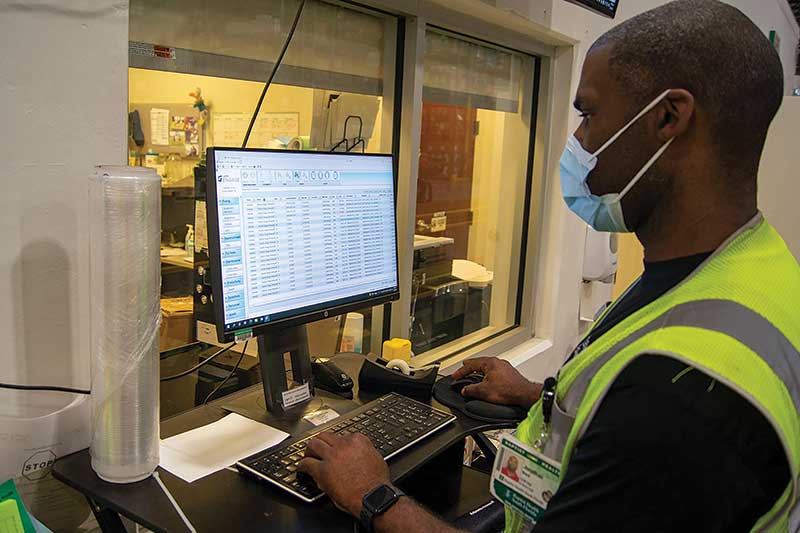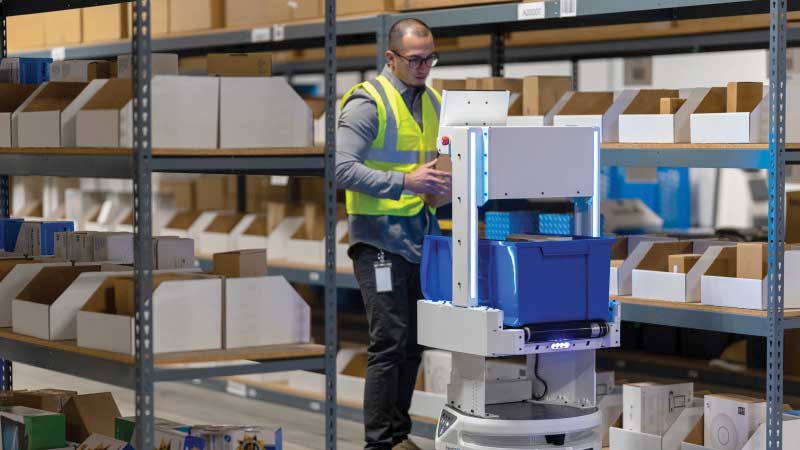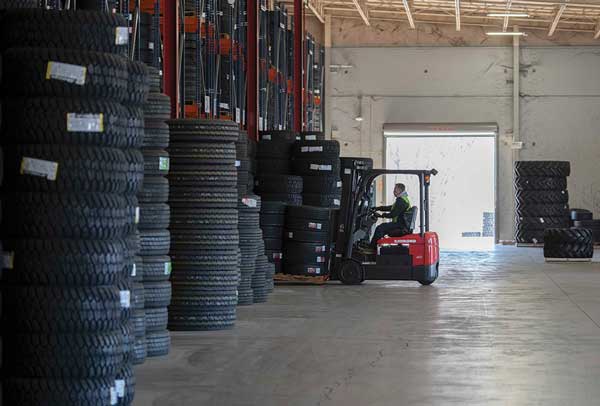Labor Management: Technology + Methods = Progress
Technology like assistive picking mobile robots, intuitive mobile devices and LMS can help overcome labor management challenges. But it also takes best practices like structured goal setting, in-person communication and employee engagement to be best positioned to maximize labor resources.

Rising use of warehouse automation and robotics the last couple of years has coincided with another trend that at first seems at odds with more automation: keen interest in labor management solutions.
After all, aren’t the robots here to replace human labor, making labor management less business critical?
The reasons why labor management remains important are multi-faceted. For one, many types of automation work collaboratively with humans, not as a total replacement.
Technology like assistive pickautonomous mobile robots (AMRs)or fixed, goods-to-person systems are designed to make work faster for human pickers, who can stay in one spot or in a much smaller zone of a DC rather than walking up and down aisles. This allows the same size team to handle more throughput or allows an operation to reassign workers to tasks that are too costly or challenging to automate.
Add in other factors like tighter service levels and more handling of eaches as part of e-commerce fulfillment, and the need for warehouse workers remains intact. In fact, the U.S. Bureau of Labor Statistics expects “materials handler” jobs to grow at a 6% clip through 2031.
The upshot is that even in this era of increasingautomation, getting more out of the hard to find and difficult to retain human workforce is more important than ever.
“Labor management is a central topic in the majority of our customer conversations, and that really goes back to how attracting and retaining the labor they need to operate is becoming more and more difficult,” saysMark Wheeler, director of Supply Chain Solutions withZebra Technologies. “As a result, most of our customers are focused on making the labor force they do have as efficient as possible, while also making sure they are providing them with an attractive place to work.”
斑马提供各种援助frontli的系统ne work, from rugged mobile devices to AMRs and software, that help execute warehouse workflows. In researching associate attitudes last year, Zebra found updated technology has appeal. Zebra’s “2022 Warehousing Vision” survey found that among associates surveyed, 92% agree that technology advances make the warehouse environment more attractive, and 83% expect the apps and devices in a DC to be as easy to use as smart phones.
“The labor force coming in today has a personal experience with technology that’s intuitive and easy to use, and they have that same expectation when they go into the enterprise,” says Wheeler. “And, if management can provide those intuitive tools, and provide jobs and workflows that are well designed in terms of how they use the technology, that tends to make the labor situation better.”
Besides tech like collaborative AMRs and intuitive devices,labor management system (LMS)solutions remain central to managing labor productivity. LMS solutions provide performance metrics and can be used to govern engineered labor standards, as well as tying into automation systems to gather data on throughput. But no one type of technology deployment ensures maximum labor productivity at a DC, as the full potential also calls for best practices such as clear goal setting and effective in-person communication.
Technology advantages
Some technology advantages are pretty straightforward in terms of the labor efficiency boost.
Assistive pick AMRs, for example, can dramatically reduce the travel required versus picking orders under a more manual process, while providing workers with user interface tools such as lights or tablets on the bots. What’s more, notes Wheeler, software can be used to optimize pick paths and coordinate warehouse activities, so people aren’t waiting on robots or vice versa.
Roboticssolutions and fulfillment management software, adds Wheeler, provide a stream of data on throughput and cycle times that can be used to fine tune processes, as well as to help manage the performance of individuals and teams.
“伟大的一件事当你start moving down the road of mechanization is you have more data about the workflow,” says Wheeler. “You’re getting more data points into the system about what happened, and when it happened, and how long each step took. The other thing that is getting a lot of traction in the market is gamification, and giving workers real-time feedback on where they’re at regarding performance. At minimum, your systems should be able to give associates that real-time feedback on where they are versus expectations.”
Other research also points to workers perceiving technology as more friend than foe. In a “Voice of the Warehouse Worker” survey released last summer byLucas Systems,a provider of warehouse execution, labor management and voice-directed solutions, the research found positive worker attitudes to warehouse technology.
In particular, 74% of associates said they would consider a pay cut at another company for an opportunity to use technology if it helps them in their job. The research also found associates typically spend over a third of their day walking and would welcome help in the form of robots or other technology that minimizes travel.
“That survey basically found that people are more apt to work for less money if the technology is better, and they have better tools,” says Dan Keller, senior consultant with Lucas Systems. “They aren’t as mercenary as we might have thought. They’re looking for a workplace that can offer some cool technologies that help them perform better. It ties back to the younger generations being so attuned to technology because it lives with them all the time.”
Another benefit of solutions like voice or wearables is that they tend to make it much faster to onboard new workers, which is a boon to both the operation and the individual, says Keller. “The first thing is to make it really, really easy to train a person off the street with your systems, because they are going to be lot happier if it doesn’t require a lot of effort to learn the tools of their new job,” says Keller.
It’s not just vendors who say technology is viewed positively by frontline workers—some major companies with fulfillment operations agree that associates like working alongside collaborative automation. Felix Vicknair, vice president of Supply Chain Solutions forKenco Group, a third-party logistics provider that has deployed assistive pick AMRs, agrees that collaborative AMRs, for example, make the human work environment better.
“We’ve found that working alongside robots not only increases warehouse employee productivity through travel reduction, but also reduces fatigue from physical exertion in many instances,” Vicknair says. “Employees enjoy interacting with robots that have digital displays and provide clear work instructions and product pictures that help improve the quality of their work.”
Best practices
Of course, technology isn’t everything, whether it’s a new LMS, or the latest wearables or mobile devices.
Even workplaces with strong technology benefit most when they have supervisors who know how to communicate and lead teams in a hands-on way, observesJason Milbrandt, senior director of client services withOpen Sky Group, a consulting firm that handles LMS deployments.
“There still needs to be daily communication, even if it’s just a quick talk with a team to say, ‘here is how we did yesterday,’ or ‘here is what we’re facing today,’” says Milbrandt. “Even if you have some technology in place [for labor management], in-person communication is still one of the best things to do. The organizations that can combine strong technology with clear communication are the ones that tend to do best at managing the labor force.”
One area technology and the coaching aspects of labor management intersect is in keeping associates informed on whether they are hitting goals. Labor management can be configured to provide workers alerts when performance is slipping, without flooding them with constant data, notes Keller.

“Certainly, setting up objectives with new employees is important, but then also, so is providing them with realistic ways to achieve those objectives, as well as interactive feedback, says Keller. “That’s the other thing often missing. They don’t know how they’re doing. We have a software capability called Speedometer that addresses this need by dynamically checking user productivity and comparing it against objectives and providing messages directly to end users to let them know if they are dropping below an objective.”
其他管理技术,如精益管理nt approaches that seek out improvement ideas from frontline workers, can also help make workplaces more attractive, and might even enhance retention (see box).
Increased pay and more flexible scheduling are also seen as ways to improve recruiting and retention. In research Kenco conducted last year, it found that 85% of supply chain leaders it surveyed said labor shortages have negatively impacted their business. The top ways respondents are trying to mitigate staffing challenges are raising wages (56%), providing flexible schedules (51%) and offering sign-on bonuses (38%).
LMS value evolves
LMS software is capable of managing performance incentives and integrating with pick rate data from automation systems. An LMS may also hold or tie into master data on SKUs for size and weight of items or cases and have data on inventory locations or even distances.
Additionally, observes Milbrandt, LMS is also used to manage engineered labor standards, which remains an important way of factoring in all the work components wrapped up in completing a larger task like executing a replenishment or picking an order. Engineered standards within LMS generate fair and accurate performance measures because of this close consideration of subtasks, says Milbrandt.
“To be really as fair as possible, you need a true labor system that’s factoring in details like larger cases that need handling in as assignment, or the number of aisles to travel,” says Milbrandt. “[LMS] takes in all those dynamics and generates a measure based on performance to a goal versus a straight units per hour metric.”
LMS解决方案可用于支持“游戏化” where a higher productivity level wins points toward a prize drawing or other incentive. LMS can help manage tiered pay incentive programs, where associates who hit a higher performance level gain a pay incentive, though usually with limited tiers, says Milbrandt. “It is usually capped after a certain level, because you want people to work safely and accurately, not just faster,” says Milbrandt. “I’m seeing pay for a performance [in LMS deployments] a bit more than gamification.”
Another LMS trend is to use the software to manage overall labor utilization at the site level, not just as carrot or stick for individuals, Milbrandt says. “Now labor management is also being used for companies to understand how effective their leadership teams are in keeping the workforce utilized,” he says. “Because it remains so hard to find and retain employees, companies are trying get the most from the overall labor resources they do have available.”
一些可以绑定到吞吐量数据fr LMS的解决方案om automation systems or robotic fulfillment solutions to compare the labor efficiencies in an automated zone with labor trends in more manual part of the warehouse.
For example, a company might want to use LMS to compare labor productivity at anautomated storage and retrieval system (AS/RS)with labor productivity for a team picking from conventional case-flow rack. In this more automated era, such comparisons can help managers make labor plans and adjustments across teams and zones of DC.
“You can still get individual productivity insights from an LMS, but it can also be used to compare productivity trends between two different processes, sort of like comparing labor productivity under your old school method, versus a part of the warehouse that uses newer technology, but still has a labor component,” adds Milbrandt.

Article Topics
Labor Management News & Resources
Logistics Labor: Increasing retention Trinet’s Managed Services: Streamlining Logistics Operations for Enhanced Efficiency A Dedicated Uniform Program Can Help Drive Your Company’s Success Association of American Railroads makes its case for rail labor deals to be ratified 31st Annual Study of Logistics and Transportation Trends: Meeting the need for talent What Workplaces Aren’t Getting from Hourly Staffing Providers Putting labor management systems (LMS) to work More Labor ManagementLatest in Logistics
FedEx finishes FY 2023 with earnings declines, amid signs of improvements OnTrac study looks at retailers’ needs for quicker deliveries as a competitive advantage May DAT Truckload Volume Index readings are stable Is Goods-to-Person Technology Right for Your Business? Working With a 3PL May Be the Best Way to Find Out Truck tonnage snaps mini-stretch of declines with May gains, reports ATA Three Questions to Ask Before Implementing Goods-to-Person Technology National diesel average trends down again, for the week of June 12, reports EIA More LogisticsAbout the Author
Subscribe to Logistics Management Magazine

Find out what the world's most innovative companies are doing to improve productivity in their plants and distribution centers.
Start your FREE subscription today.
June 2023
万博2.0app下载

Latest Resources


 Hesselbein Tire found that lean management methods improved employee engagement.
Hesselbein Tire found that lean management methods improved employee engagement.











